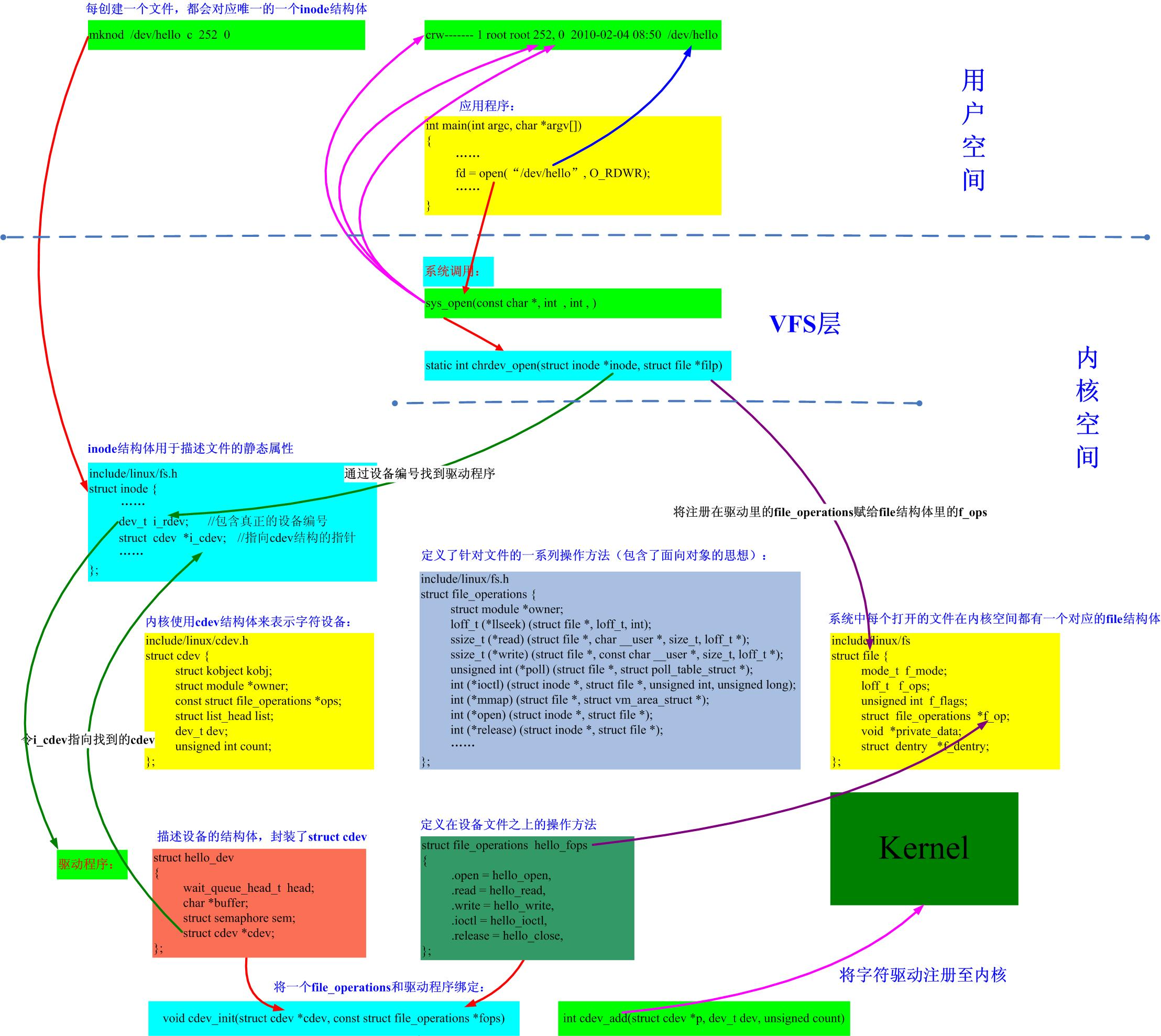Home >System Tutorial >LINUX >Device files in Linux systems: inode, file and file_operations
Device files in Linux systems: inode, file and file_operations
- WBOYWBOYWBOYWBOYWBOYWBOYWBOYWBOYWBOYWBOYWBOYWBOYWBforward
- 2024-02-13 10:20:38797browse
The device file is a special file in the Linux system. It is used to represent the interface of the device so that user space programs can access the device through file operations. The implementation of device files involves three important structures: inode, file and file_operations. The inode structure is used to store metadata of device files, such as device number, permissions, size, etc. The file structure is used to store status information of device files, such as current location, open mode, private data, etc. The file_operations structure is used to store device file operation functions, such as open, read, write, close, etc. In this article, we will introduce the definitions and functions of these three structures, and give examples of their usage and precautions.

The driver controls the hardware downwards and provides interfaces upwards. The upwardly provided interfaces here ultimately correspond to the application layer in three ways: Device files, /proc, /sys, the most commonly used ones are Use device files, and the most commonly used Linux devices are character devices. This article uses character devices as an example to analyze the internal mechanism of creating and opening a character device file.
struct inode
Everything in Linux is a file. When we create a file in Linux, an inode will be created in the corresponding file system to correspond to it. The file entity and the inode of the file are in one-to-one correspondence , the created inode will be stored in the memory. The first open will have a backup of the inode in the memory. The same file is opened multiple times and multiple inodes will not be generated. When all opened files are closed, , the inode instance in memory will be released. In this case, when we use mknod (or other methods) to create a device file, an inode will also be created in the file system. This inode, like other inodes, is used to store static information (immutable information) about the file. ), including the device number corresponding to this device file, the path of the file and the corresponding driver object etc. As one of the four major objects of VFS, inode rarely needs to be filled by ourselves in driver development. It is more necessary to view it in the open() method and fill in our file structure as needed.
For different file types, the filled member contents of the inode will also be different. Taking the creation of a character device as an example, we know that add_chrdev_region actually combines a driver object and a (group) Device numbers are linked together. Creating a device file actually connects device file and device number. At this point, these three are bound together. In this way, the kernel has the ability to create an instance of struct inode. The following is the inode in the 4.8.5 kernel. This inode is the inode of VFS, which is a further encapsulation of the inode of the most specific file system. It is also the inode that is concerned in driver development. For specific file systems, there are also structures such as struct ext2_inode_info.
//include/linux/fs.h
596 /*
597 * Keep mostly read-only and often accessed (especially for
598 * the RCU path lookup and 'stat' data) fields at the beginning
599 * of the 'struct inode'
600 */
601 struct inode {
602 umode_t i_mode;
603 unsigned short i_opflags;
604 kuid_t i_uid;
605 kgid_t i_gid;
606 unsigned int i_flags;
607
608 #ifdef CONFIG_FS_POSIX_ACL
609 struct posix_acl *i_acl;
610 struct posix_acl *i_default_acl;
611 #endif
612
613 const struct inode_operations *i_op;
614 struct super_block *i_sb;
615 struct address_space *i_mapping;
616
617 #ifdef CONFIG_SECURITY
618 void *i_security;
619 #endif
620
621 /* Stat data, not accessed from path walking */
622 unsigned long i_ino;
623 /*
624 * Filesystems may only read i_nlink directly. They shall use the
625 * following functions for modification:
626 *
627 * (set|clear|inc|drop)_nlink
628 * inode_(inc|dec)_link_count
629 */
630 union {
631 const unsigned int i_nlink;
632 unsigned int __i_nlink;
633 };
634 dev_t i_rdev;
635 loff_t i_size;
636 struct timespec i_atime;
637 struct timespec i_mtime;
638 struct timespec i_ctime;
639 spinlock_t i_lock; /* i_blocks, i_bytes, maybe i_size */
640 unsigned short i_bytes;
641 unsigned int i_blkbits;
642 blkcnt_t i_blocks;
643
644 #ifdef __NEED_I_SIZE_ORDERED
645 seqcount_t i_size_seqcount;
646 #endif
647
648 /* Misc */
649 unsigned long i_state;
650 struct rw_semaphore i_rwsem;
651
652 unsigned long dirtied_when; /* jiffies of first dirtying */
653 unsigned long dirtied_time_when;
654
655 struct hlist_node i_hash;
656 struct list_head i_io_list; /* backing dev IO list */
657 #ifdef CONFIG_CGROUP_WRITEBACK
658 struct bdi_writeback *i_wb; /* the associated cgroup wb */
659
660 /* foreign inode detection, see wbc_detach_inode() */
661 int i_wb_frn_winner;
662 u16 i_wb_frn_avg_time;
663 u16 i_wb_frn_history;
664 #endif
665 struct list_head i_lru; /* inode LRU list */
666 struct list_head i_sb_list;
667 struct list_head i_wb_list; /* backing dev writeback list */
668 union {
669 struct hlist_head i_dentry;
670 struct rcu_head i_rcu;
671 };
672 u64 i_version;
673 atomic_t i_count;
674 atomic_t i_dio_count;
675 atomic_t i_writecount;
676 #ifdef CONFIG_IMA
677 atomic_t i_readcount; /* struct files open RO */
678 #endif
679 const struct file_operations *i_fop; /* former ->i_op->default_file_ops */
680 struct file_lock_context *i_flctx;
681 struct address_space i_data;
682 struct list_head i_devices;
683 union {
684 struct pipe_inode_info *i_pipe;
685 struct block_device *i_bdev;
686 struct cdev *i_cdev;
687 char *i_link;
688 unsigned i_dir_seq;
689 };
690
691 __u32 i_generation;
692
693 #ifdef CONFIG_FSNOTIFY
694 __u32 i_fsnotify_mask; /* all events this inode cares about */
695 struct hlist_head i_fsnotify_marks;
696 #endif
697
698 #if IS_ENABLED(CONFIG_FS_ENCRYPTION)
699 struct fscrypt_info *i_crypt_info;
700 #endif
701
702 void *i_private; /* fs or device private pointer */
703 };
The main members related to this article are:
“
struct inode
–602–>i_mode indicates access permission control
–604–>UID
–605–>GID
–606–>i_flags file system flags
–630–>Hard link count
–635–>i_size file size in bytes
–636–>Last access time
–637–>Last modify time
–638–>Last change time
–669–>i_dentry; //Catalogue necklace list
–673–>i_count reference count, when the reference count becomes 0, the inode instance will be released
–675–>i_writecountWriter count
–679–>When creating a device file, i_fops is filled with one of def_chr_fops, blk_blk_fops, def_fifo_fops, and bad_sock_fops. See init_special_inode()
called during the creation process. –683–>Special file types such as union, pipe, cdev, blk.link etc. i_cdev indicate that this inode belongs to a character device file. When creating the device file in this article, the driver object cdev of the related device number will be used. filling
–702–>Private data of inode”
Only the above members struct def_chr_fops are worth pursuing, they will be of great use later:
//fs/char_dev.c
429 const struct file_operations def_chr_fops = {
430 .open = chrdev_open,
431 .llseek = noop_llseek,
432 };
struct file
Linux内核会为每一个进程维护一个文件描述符表,这个表其实就是struct file[]的索引。open()的过程其实就是根据传入的路径填充好一个file结构并将其赋值到数组中并返回其索引。下面是file的主要内容
//include/linux/fs.h
877 struct file {
878 union {
879 struct llist_node fu_llist;
880 struct rcu_head fu_rcuhead;
881 } f_u;
882 struct path f_path;
883 struct inode *f_inode; /* cached value */
884 const struct file_operations *f_op;
885
886 /*
887 * Protects f_ep_links, f_flags.
888 * Must not be taken from IRQ context.
889 */
890 spinlock_t f_lock;
891 atomic_long_t f_count;
892 unsigned int f_flags;
893 fmode_t f_mode;
894 struct mutex f_pos_lock;
895 loff_t f_pos;
896 struct fown_struct f_owner;
897 const struct cred *f_cred;
898 struct file_ra_state f_ra;f
904 /* needed for tty driver, and maybe others */
905 void *private_data;
912 struct address_space *f_mapping;
913 } __attribute__((aligned(4))); /* lest something weird decides that 2 is OK */
“
struct file
–882–>f_path里存储的是open传入的路径,VFS就是根据这个路径逐层找到相应的inode
–883–>f_inode里存储的是找到的inode
–884–>f_op里存储的就是驱动提供的file_operations对象,这个对象在open的时候被填充,具体地,应用层的open通过层层搜索会调用inode.i_fops->open,即chrdev_open()
–891–>f_count的作用是记录对文件对象的引用计数,也即当前有多少个使用CLONE_FILES标志克隆的进程在使用该文件。典型的应用是在POSIX线程中。就像在内核中普通的引用计数模块一样,最后一个进程调用put_files_struct()来释放文件描述符。
–892–>f_flags当打开文件时指定的标志,对应系统调用open的int flags,比如驱动程序为了支持非阻塞型操作需要检查这个标志是否有O_NONBLOCK。
–893–>f_mode;对文件的读写模式,对应系统调用open的mod_t mode参数,比如O_RDWR。如果驱动程序需要这个值,可以直接读取这个字段。
–905–>private_data表示file结构的私有数据”
我在Linux设备管理(二)_从cdev_add说起一文中已经分析过chrdev_open(),这里仅作概述。
//fs/chr_dev.c
348 /*
349 * Called every time a character special file is opened
350 */
351 static int chrdev_open(struct inode *inode, struct file *filp)
352 {
/* 搜索cdev */
...
390 replace_fops(filp, fops);
391 if (filp->f_op->open) {
392 ret = filp->f_op->open(inode, filp);
393 if (ret)
394 goto out_cdev_put;
395 }
...
402 }
可以看出,这个函数有三个任务(划重点!!!):
“
chrdev_open()
–352-389–>利用container_of等根据inode中的成员找到相应的cdev
–390–>用cdev.fops替换filp->f_op,即填充了一个空的struct file的f_op成员。
–392–>回调替换之后的filp->f_op->open,由于替换,这个其实就是cdev.fops”
至此,我们知道了我们写的驱动中的open()在何时会被回调,这样我们就可以实现很多有意思的功能,比如,
我们可以在open中通过inode->cdev来识别具体的设备,并将其私有数据隐藏到file结构的private_data中,进而识别同一个驱动操作一类设备;
我们也可以在回调cdev.fops->open()阶段重新填充file结构的fop,进而实现同一个驱动操作不同的设备,这种思想就是内核驱动中常用的分层!
最后总结一下这些结构之间的关系:
“
”
Through this article, we have learned about the three important structures of device files: inode, file and file_operations. They can be used to manage and operate device files. We should choose the appropriate structure according to actual needs and follow some basic principles, such as using the correct device number, using reasonable permissions, using effective operating functions, etc. The three structures of the device file are one of the most basic concepts in the Linux system. They can abstract and encapsulate the device, and can also improve the unity and flexibility of the system. I hope this article can be helpful and inspiring to you.
The above is the detailed content of Device files in Linux systems: inode, file and file_operations. For more information, please follow other related articles on the PHP Chinese website!


